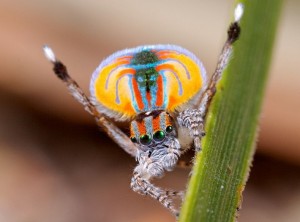Make me one . . . with everything
The Maker Faire is coming back to the Bay Area, presumably bigger and better than ever, and stickier (from all those glue guns). I love the idea but I’ve never been. You know why? There are too many crafty people around here, and they snag all the parking and crowd the tofu-dog stands and get in the way so I can’t see the robots doing yoga! Or the self-washing dogs, or the bamboo cars. Um, I’m not exactly sure what they have on tap this year.
Spiders are makers, too, to be faire (heh). Not just takers, although they do have to take life to exist. A blog posting today from the esteemed biologist Jerry Coyne points out a spider that makes what looks like art but has some deep, and still undiscovered, purpose.
You already know about the spider that makes piñatas.
Coyne singled out a Namibian spider that lives in the ground and arranges rocks around the entrance of its burrow. It’s been noted that it usually chooses seven rocks, but as Coyne explains, that could just be due to the size of the spider and of the typical local rock. The pattern the rocks make is a purty flower (below).

Daisy, daisy, give me your answer, do. The flower bower of a Namibian spider in the family Segestriidae. (Photo by G. Costa et al., Journal of Arid Environments, 1995)
Cute, of course. But why? As usual with spiders, they’ve had 400 million years’ practice at keeping secrets. They’re masters at “no comment.”
Coyne’s possibilities include: the rocks help keep wind-blown sand out of the burrow, they disguise the spider’s hideout from predators, they somehow attract prey, or they serve as landmarks for the very nearsighted spider. No experiments have been performed to make these anything other than guesses, he notes.
The most tantalizing part of the whole setup—it’s a little eerie—is how the spider arranges its daisy. The narrow part of the rock points in, the broad part outward; that’s what makes the flower shape so lovely, so natural-looking. There has to be a well-engineered reason for that. But now we’re talking about how a mason would think. This spider, mysteriously, has enough brainpower to comprehend how the rocks fit. And they’re not even touching.
Radial symmetry is the heart of what web-spinning spiders do; we’ve all seen those marvelous mandalas in the garden. The orb weaver’s talent for engineering is well studied. But the Namibian spider is a reminder that every small animal has its bag of tricks, tools honed for its environment and often entirely unseen by us.
The yellow sac spiders that bivouac in the cracks spin a silk sleeping bag that would be the envy of any mountain climber. The black widows in the fence (yes, they came back from wherever they went during construction) maintain a tangled, most haphazard capture web, but look close and you see that it couldn’t be more perfect for catching prey, slowing down intruders, and giving the clumsy widow a fighting chance at escape.
And the jumping spiders—they’re a little more obvious, I guess. Anybody could figure out the survival value of a rainbow afro or really good dance moves. Preferably combined! If the jumping spiders ever discover Namibian flower power, they’ll be unstoppable.
